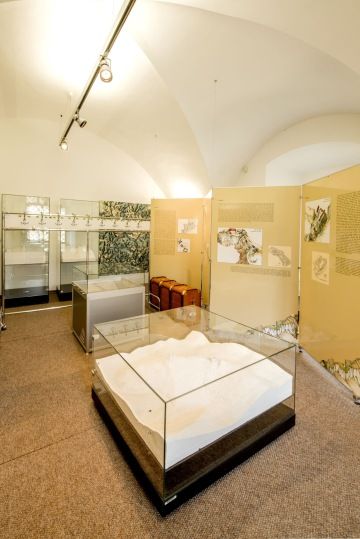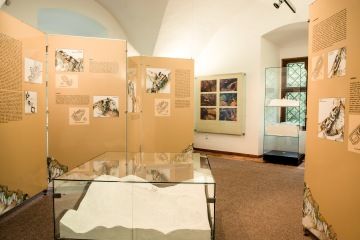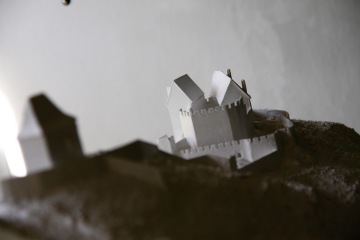Hrady blanenského okolí
osidlování neobydlených oblastí a budování nových sídel na Blanensku
Kolonizace na Blanensko pronikala proti toku řek a podél staré zemské cesty, tzv. Trstenické stezky.
Jejím výsledkem byl i vznik řady hradů, které představuje tato expozice.
Nejstaršími kolonizátory v této oblasti byly církevní instituce, což platí zejména pro Blanensko, jež bylo doménou olomouckých biskupů.
Biskup Bruno ze Schauenburgu nechal v polovině 13. století jako středisko zdejšího panství založit hrad Blansko (Blansek) a snad i tzv. Čertův Hrádek u Olomučan.
Ve 13. století se však začínají objevovat i první sídla šlechtická, k nimž patří Doubravice, Holštejn, Černá Hora a další.
Hrady v okolí Blanska představují ukázky několika stavebních typů: bergfritového (Doubravice), hradu s obvodovou zástavbou (Blansek), bezvěžového (Holštejn) či zcela unikátního a v našich zemích jediného jeskynního hradu v Rytířské jeskyni. Jsou zde i dva menší, převážně dřevěné hrádky, jejichž existence trvala jen velmi krátce (Babice, Lečenec).
Většina z hradů, o nichž expozice pojednává, v průběhu staletí zanikla a zůstává ve více či méně patrných troskách. Jejich zánik způsobily buď války mezi moravskými markrabaty na přelomu 14. a 15. století, nebo války husitské či česko-uherské ve druhé polovině 15. století. V některých případech byly staré hrady opuštěny a nahrazeny pohodlnějšími sídly. Do dnešní doby tak „přežívají“, byť ve značně pozměněné podobě, jediné dvě stavby, a to zámky v Blansku a Černé Hoře.
Vzhledem k historickým souvislostem byl záběr expozice poněkud rozšířen mimo bezprostřední okolí Blanska, takže zahrnuje i některé další hrady např. v údolí Svitavy či poněkud vzdálený Vildenberk, který ovšem býval v minulosti ztotožňován s Novým Hradem u Adamova. Textovou část doplňují názorné kresebné rekonstrukce jednotlivých sídel od Ing. arch. Šimečka a modely několika zajímavých hradních staveb z popisované oblasti, vytvořené panem Zdeňkem Brachtlem.



EN: The oldest colonizers in this area were church institutions, which is especially true for Blansko, which was the domain of the bishops of Olomouc. Bishop Bruno of Schauenburg had the castle of Blansko (Blansek) and perhaps the so-called Devil's Castle near Olomučany established in the middle of the 13th century as the centre of the local estate. In the 13th century, however, the first noble settlements began to appear, including Doubravice, Holštejn, Černá Hora and others. The castles in the vicinity of Blansko are examples of several building types: bergfrit castle (Doubravice), castle with a perimeter building (Blansek), towerless castle (Holštejn) or the unique and the only cave castle in our country in the Knights' Cave. There are also two smaller, mostly wooden castles whose existence lasted only a very short time (Babice, Lečenec).
Most of the castles described in the exhibition have disappeared over the centuries and remain in more or less visible ruins. Their demise was caused either by the wars between the Moravian margraves at the turn of the 14th and 15th centuries or by the Hussite or Bohemian-Hungarian wars in the second half of the 15th century. In some cases, the old castles were abandoned and replaced by more comfortable residences. Thus, only two buildings survive to this day, albeit in a considerably altered form, namely the castles in Blansko and Černá Hora. Due to the historical context, the scope of the exposition has been extended somewhat beyond the immediate surroundings of Blansko to include some other castles, e.g. in the Svitava valley or the somewhat distant Vildenberk, which, however, used to be identified with Nový Hrad near Adamov. The text part is supplemented by illustrative drawings of individual settlements by Ing. arch. Šimeček and models of several interesting castle buildings from the described area, created by Mr. Zdeněk Brachtl.
